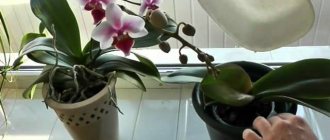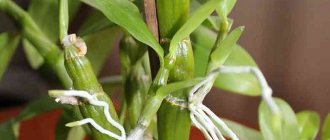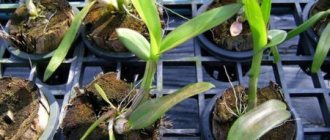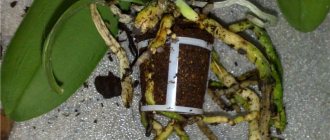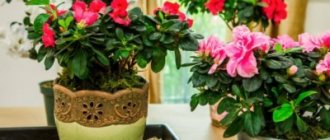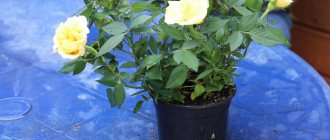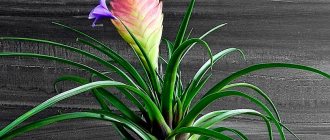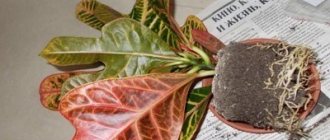General information about Phalaenopsis
The first plants were discovered on the Moluccas in the middle of the 18th century. In the first half of the 18th century, similar flowers were found on the Malay Islands, and it was then that the orchid was given the name phalaenopsis, which means “butterfly-like.”
In nature, there are more than twenty thousand species of these plants, in addition, many hybrids have been bred, and it is no coincidence that phalaenopsis is so common in home floriculture. Externally, the plants are small bushes with a rosette of leathery leaves from which flower stalks emerge. The length and shape of the peduncles are different and depend on the characteristics of the particular type of orchid: tall, hanging, curved.
Phalaenopsis has a very short stem (monopodial appearance), aerial roots, the surface of which is covered with velamen. The color of the roots is greenish, as they participate in the synthesis of chlorophyll.
These plants are epiphytes, although lithophytic species are also found. In nature they grow on tree trunks and branches, but are not parasites. Food is obtained from plant residues accumulating in the bark, moisture is obtained from air and precipitation.
The flowers are shaped like moths, sizes vary from 3 to 14-15 cm. The number also varies, some phalaenopsis produce 5-10 flowers, others - up to 50-60 flowers.
On a note! The natural color of flowers of this genus of Orchids is white.
The hybrids bred by breeders have petals of various shades, including those with the famous “French specks” - dark dots on a light background. Hybrids of mini and macro orchids have been created, with and without odors. The stores offer various varieties of phalaenopsis, which are eagerly snapped up by customers. But you need to know the characteristics of this type of exotic plant and follow simple growing recommendations.
Description and distinctive features of the species
Popular colors of phalaenopsis, including varieties of blue and green orchids.
Orchid mix is widespread among both experienced gardeners and beginners. What is this, Phalaenopsis mix orchid? If we talk about phalaenopsis itself, it is a perennial herbaceous plant of the orchid family. It has quite compact dimensions. The flower consists of several large leaves of an oblong and blunt shape. Usually their number varies from 3 to 12, and they are all leathery, fleshy and dense. The leaf length is usually from 15 to 25 cm. They grow from a small rosette, usually no more than 10 cm in height, and smaller in young plants.
In the store, these plants are always presented with a peduncle. It is a long, thin stem that is dark green or greenish brown in color. The flower arrow is not permanent and dries out after one or several flowerings. Sometimes all at once, and sometimes partially.
The flowers of this plant consist of 3 sepals and 3 petals, one of which has an unusual fused shape. The name phalaenopsis comes from Greek words, and translates as “moth-like.” And it is named so precisely because of the unusual shape of the flowers, which from a distance really resemble a flock of butterflies.
One peduncle can have from 7 to 40 flowers. The amount depends both on the variety and on the conditions of maintenance and age of the plant. Flowers can also vary in diameter, from 2 to 15 cm.
The prefix “mix” itself means that it is a hybrid plant. Essentially, for the grower, this means that the flower is adaptable and easier to care for than some other species.
It is important to note that this is an epiphytic plant. Its roots are aerial, and when grown in a pot, no soil is used
Epiphytes require a special substrate, the same as what is in it when purchased.
How to choose Phalaenopsis?
If you want to purchase a luxurious flower, you need to carefully choose the plant you like:
- Phalaenopsis should be healthy, with a large number of unopened buds, with elastic leaves.
- It is advisable to choose orchids growing in transparent pots. This makes it easier to inspect the root system of plants and see possible damage. The roots should be grayish, in those places where light reaches them - green. Brown or dark roots indicate that the plant is not entirely healthy and it is better not to purchase it.
- You should not buy phalaenopsis with wrinkled, dry leaves.
- You should also refrain from buying a plant that does not “sit” tightly in the substrate and pot, and its roots are obviously damaged.
Those who have experience growing a marvelous flower can purchase a plant with minor damage. Their price is lower, and if you have the desire and time, then it is quite possible to revive phalaenopsis.
Description of species and photos
Orchid Mix
Sunny, warm, very tender, the flowers are a pleasant bright yellow color, like magic lanterns. This Mix is very easy to care for. Fills the surrounding world with a positive, life-giving aura. Its height is 12 -15 cm, the leaves are bright green, oblong.
Orchid Mix 2 stems
Bright, variegated, rich flowers of this species can be snow-white, modest and meek, or they can be a defiant burgundy hue. This is an unpretentious miracle - a hybrid with two trunks, densely strewn with inflorescences of the most amazing colors and shades. The flower is unpretentious, loves the sun and warmth, and in return gives the same range of positive emotions.
Differences in flower maintenance at home and in the store
Despite its unpretentiousness, phalaenopsis requires the creation of special conditions indoors. The flower's homeland is tropical forests, where there is enough light, heat and moisture, so it is necessary to create similar conditions for the orchid.
After purchasing the orchid, they select a place in the house that is light and warm enough, install a pot and leave the plant alone for a while. It is necessary to observe the flower and its condition for about 1.5-2 weeks.
Phalaenopsis mix
Extra
An even more attractive type of orchid for home growing. They are distinguished by a wide range of colors with various inclusions, multicolor and even more saturated color.
In popular scientific literature there are no names such as “mix” or “extra mix”. These are commercial names that give sellers the opportunity to somehow systematize a wide range of this amazing plant.
Photo of orchid mix extra.
Multifloral
It got its commercial name for its many flowers. Their number can reach up to 15 pieces simultaneously on each peduncle.
Particularly appreciated is cap flowering, when the flowers are collected in multi-flowered racemes.
They are characterized by long blooming and prolonged flowering.
Phalaenopsis multiflorum.
In nature
If we exclude the commercial component, when the name is given for systematization, and rely on the scientific one, then the Mix is plants of the same species, but of different colors. Accordingly, this species occurs in nature, since pollination occurs constantly.
Is a transplant necessary after purchase?
Experienced flower growers always replant an orchid after purchase, thereby saving the flower from death. In stores (especially on sales in supermarkets), phalaenopsis is often sold in pots with peat tablets or baskets, moss plugs, foam rubber, lightly covered with bark or special coconut chips. This is done for the convenience of transporting plants and preserving moisture for the roots.
After purchasing without replanting, the orchid is watered in the usual manner for this plant, so the roots do not have time to dry out, the humidity rises, and rotting processes begin. First, the roots rot, then the process moves to the neck, the plant turns yellow, stops growing and dies without surgical treatment.
Conclusion: after purchase, the exotic Phalaenopsis is replanted, moss, peat baskets, and other moisture-intensive materials are removed and a substrate is added to the pot.
Water and fertilizer
What care is there without proper fertilization and watering? Water should be a nutritious liquid. Purified and distilled ones will not work. Good from a natural source that is rich in beneficial microelements.
You can additionally dissolve fertilizers in water. But the concentrated liquid is poured only into a pot with moistened roots, so as not to burn them.
Phalaenopsis copes well with long droughts. But only if the cases are rare, and not regular and long-lasting.
It is necessary to ensure humidity within 50-80%. Successful plant care requires this. There are several methods of provision:
- Spraying. Spray the phalaenopsis leaves evenly using a spray bottle. The main rule is to wet the orchid leaf, and not to make it rain. Drops should not form and flow into the pot. A light damp coating should appear on the orchid.
- Wet cloth effect. Regularly place a piece of wet cloth on the battery and radiator. Evaporation will give the desired result.
- Pot stand. Use a tray with small pebbles, which you periodically spray generously with water. No need to make a puddle there. Just wet the stones.
In the summer at home there is low humidity in the air due to the heat, and in the winter due to the dry heat of the heating system. As it dries, use techniques to increase the plant's humidity.
Step by step instructions
We will describe in detail all the steps for choosing and creating optimal conditions for growing phalaenopsis.
Selecting a location
The usual placement of flowers in an apartment is window sills or special stands. For tropical beauties, an eastern window is suitable, where there is enough light, but at the same time there is no direct sunlight.
Phalaenopsis loves diffused light and blooms profusely in the back of rooms, provided that there is at least 12 hours of daylight. When placing the pot on the south side, in the summer you need to make a little shading for the orchid. If there are not enough hours of daylight, fluorescent lamps are used for additional illumination.
On a note!
During the formation of flower buds, the plant is not recommended to be moved or transferred from place to place.
The flower reaches for the light and, in order to avoid getting a one-sided plant or one that falls to one side, carefully turn the pot.
Humidity and temperature
Residents of the tropics, phalaenopsis are demanding of air humidity and a certain temperature. In city apartments, the air, especially in winter when the heating is on, is too dry, so humidifiers must be used.
A good option is pallets with pebbles, expanded clay, into which water is poured. The pot with the orchid is placed on pebbles (not in water) so that the plant is in comfortable conditions.
Spraying phalaenopsis is allowed, but moderately and only in the first half of the day. During the procedure, it is important that water does not linger in the axils of the leaves, at the point of growth, otherwise the plants will rot. In the summer, containers with water are placed near the orchid pot.
The premises are regularly ventilated, preventing drafts from entering the plants.
The best temperature for Phalaenopsis is from +24ºC...+29ºC in summer and +17ºC...+25ºC in winter. Plants do not have a pronounced dormant period; to stimulate the formation of flower buds, the temperature will need to be slightly reduced to +17ºC. The phalaenopsis is kept in this mode for 2-2.5 weeks, until the formation of buds begins.
It happens that the temperature in the room has dropped. A short-term change in indicators for phalaenopsis (for 1-3 days) to +11ºC...+15ºC is not so critical, but you must still try to prevent this. When the temperature drops for a long time, diseases occur and the plant may die. One of the common mistakes of novice gardeners is intensive watering of an orchid that has withered from the cold. When the temperature drops, the root system of the plant loses its ability to absorb nutrients and moisture, the leaves lose turgor and wrinkle. Increased watering leads to a worsening of the situation, the roots rot and the orchid becomes difficult to revive. Therefore, you always first need to find out the reason for the deterioration of the flower’s condition, and only then take some measures.
First watering
When growing Phalaenopsis, follow the watering regime. The first time after purchase, plants are not watered immediately, but after adaptation. In this case, it is necessary to inspect the roots of the plants and the substrate, removing all moisture-intensive materials from it.
Orchids of this species love moderate watering, tolerate short droughts, but suffer from irregular moisture supply. The optimal watering regime is selected taking into account the room conditions, temperature, humidity, time of year, as well as the condition of the plants themselves.
Schedule (approximate):
- in summer - once every 3-4 days;
- in winter - once every 10-14 days;
- in autumn and spring - once every 6-8 days.
Use clean, filtered, slightly warm water. Orchids are watered in the first half of the day so that by evening the plant dries out slightly. It is best to water an orchid by placing the flower pot in a bowl of water. Time – 2-3 hours. During this period, the bark of the substrate will be saturated with water, the roots will “take” the required amount of moisture.
Another option is to place the pot in a sink or basin and gently water the substrate for 12-15 minutes. The excess drains into the pan, then the pot is returned to its usual place. In order to accurately determine that phalaenopsis needs watering, inspect the roots of the plant and the substrate. The pot has become light, which means it’s time to water the orchid, but strictly observing the norm. Also, the need for watering is indicated by a change in the color of the flower roots; they become light gray or silver.
Important!
The orchid should not dry out completely! A slightly moistened substrate is a guarantee that the plant will not experience discomfort or lack of moisture.
Excessive moisture leads to rot and plant diseases. Therefore, compliance with the norms and watering schedule is a prerequisite for the normal growth of phalaenopsis.
Care instructions
Any indoor flower requires certain conditions for growth and flowering. The best conditions for a mini orchid are:
- room temperature without sudden changes;
- maintaining moist air;
- Avoid exposing the plant to direct sunlight;
- fertilize the flower according to the instructions
How to fertilize?
- The orchid needs to be fertilized no earlier than one and a half to two months after transplantation.
- You should not fertilize plants that have rot.
- You can fertilize the plant only after watering.
- In summer, the orchid needs to be fertilized 2 times a month, in winter - no more than once a month.
- Do not fertilize your orchid while it is blooming.
Popular articles Phalaenopsis Orchid: main types and home care options
Types of fertilizers:
- Root. Used to stimulate plant growth. After watering, following the instructions on the package, you need to dilute the fertilizer in water and place it in the ground with the flower. After fertilizing, the flower should be moved to a warm room for several hours. At the same time, if the flower is located near a window or balcony, it should be moved to different points in the room so that direct light from the sun does not fall on the plant.
- Foliar. In this case, the orchid should not be watered, but sprayed. Also, following the instructions, you should dilute the fertilizer in water and apply it to the leaves of the plant using a spray bottle. And in this case, during fertilization, the leaves should not be exposed to direct sunlight. Avoid getting fertilizer on buds and flowers. It is necessary to fertilize the plant every 10-14 days during the period of active growth of mini-orchids, and no more than once a month during the dormant period. This period is characterized by the suspension of physiological processes. Visually, the plant in this state does not grow and does not show significant changes. During the dormant period, it is not recommended to fertilize the plant. For mini-orchids these are the periods of summer (hot months) and late autumn.
How to transplant?
You can use the general step-by-step instructions for replanting orchids, keeping in mind the following features of replanting miniature orchids:
- If your miniature orchid grows on a “cushion” of moss, then you need to replant such an orchid once a year. The mini-orchid should be replanted in the spring during the period of active growth and until the peduncle is completely formed.
- To separate old soil or moss from the orchid's roots, place the orchid in a container of water for a few minutes. Let the water saturate the soil (moss) and separate the orchid roots from the soil one by one.
- If you decide to transplant an orchid into soil consisting of bark, then use soil consisting of fine pieces of bark.
The pot for a mini orchid should be a little tight. Thus, it ensures good breathability of the orchid soil. You can use the transparent pot in which the orchid grew, after washing it thoroughly.
We recommend watching a video about how to properly transplant a mini-orchid:
Reproduction nuances
In the case of mini-orchid propagation, a “child” is used, which is separated from the flower (vegetative propagation method). When a new shoot appears, it is carefully removed. Then it is immersed in a greenhouse, which has previously been laid out with wet sphagnum (peat moss).
How to replant phalaenopsis correctly?
After purchasing a flower in a store, it must be replanted. By acting carefully and following simple recommendations, the transplantation process will not take much time, and even a blooming orchid will not feel any stress.
Basic Rules:
- The pot in which the phalaenopsis grew in the store must be changed.
- The old soil is inspected; if it is suitable for cultivation, it is used again, mixed halfway with the new substrate. Be sure to remove plugs, tablets of moss, peat or foam rubber.
- The best substrate for growing orchids is bark and peat, bark and peat moss. Specialized stores sell ready-made soils for orchids:
- Take a new pot of the same size or slightly larger in volume. It is advisable to use transparent plastic containers, as the roots of the plants are visible in them.
- The flower container is disinfected: washed with soap and water and dried. It is advisable to calcinate the substrate in the oven.
- Before transplanting, carefully examine the roots of the phalaenopsis. Armed with a sharp knife, remove all deformed, black, weak roots. The sections are disinfected with an alcohol-free antiseptic.
- Dried and withered leaves are removed by carefully cutting them and removing them from the stem.
- Place the orchid in a new pot, choose the best position (take into account the growth point), sprinkle with substrate.
Attention!
If the plant stem is slightly bent, do not straighten it. This is the specificity and peculiarity of the growth of a particular specimen, so let it continue to grow like this.
- After proper transplantation, the phalaenopsis stands firmly and firmly in the pot and does not lean to the sides.
- The plant is placed in moderate shade so that it takes root in its new location within 7-10 days. Water no earlier than every 4-5 days.
- Fertilizing with fertilizers is done after 10-12 days.
You may be interested in: How to care for orchids in a pot after purchase Why the leaves of an orchid wither and how to save it Features of the care and propagation of the Dendrobium Nobile orchid
The detailed recommendations for replanting Phalaenopsis after purchase are also suitable for regular planned plant replanting. It is carried out once every 2-3 years, choosing the most optimal time. This is usually spring, when the flower grows roots and new leaves, so transferring it to a new substrate will be less painful.
When to replant an orchid:
- after the purchase;
- when the roots of the plant are damaged (usually occurs due to excessive moisture);
- when the pot becomes too small for the root system of the flower;
- to replace the substrate.
The substrate for orchids must be loose, with a certain level of acidity, balanced in salt content. A change in the structure of the soil leads to a loss of its beneficial properties, the roots of phalaenopsis do not receive the required amount of moisture, the water stagnates, which leads to infections.
For substrates use:
- crushed bark (sizes 1-2 cm);
- coconut chips;
- sphagnum (no more than 18-20% of the composition);
- dried fern roots (no more than 18-20%).
From ready-made soils, “Durpeta”, “Compo Sana”.
When transplanted, the roots of the plant are very intertwined. To better clean them from the old substrate, the plant roots are immersed in warm water to soak. Then, after examining and removing dry and old roots, the orchid is dried for several hours and only then transplanted into a new container.
What does it look like?
Phalaenopsis Mixes have large, fleshy leaves of a bright green color. The leaf blade is oblong, rounded. Some subcultivars have spotted leaves.
Peduncles are formed in the leaf axils. The number of peduncles is 1 – 3, depending on the variety. 25–40 flowers are densely placed on each peduncle. Peduncles are straight, branching at the tops.
The flowers are numerous and have the traditional butterfly shape of all phalaenopsis. Many varieties are distinguished by fragrant flowering. In terms of color, Mixes have a wide color spectrum - white, yellow, purple, burgundy. There are flowers of variegated colors with various inclusions, patterns and edging. Flower size 2 – 10 cm.
The root is fragile, brittle, branched.
Conditions under which an orchid will bloom
Seeing a blooming phalaenopsis in a store, many, without hesitation, buy this luxurious flower. But after a while, when the plant fades, after a period of dormancy, it can be difficult to achieve repeated flowering.
Even for the fairly unpretentious Phalaenopsis, certain conditions for flowering must be created.
- Moderate regular watering. The substrate is watered only when it dries out, avoiding excess soil moisture. After the orchid has completely bloomed, stop watering for 30-35 days.
- Choosing the right place for the plant. It should be taken into account that orchids do not like “moving”, so starting from the moment of flowering, do not touch or rearrange the pot.
- Phalaenopsis will bloom only with sufficient light. The flower requires about 11-12 hours of light, so orchids blooming in winter must be illuminated with phytolamps.
- Growing phalaenopsis in ceramic pots is not allowed. The roots of the plant participate in the process of photosynthesis; they need light. Select special transparent plastic containers through the walls of which light enters the root system. In addition, roots do not grow to plastic surfaces, which avoids deformation.
- Consider the age of the phalaenopsis. The plant “throws out” the peduncle only after reaching 2-3 years of age. The number of leaves will allow you to determine how old an orchid is; if there are from 5 to 8-9, then you should expect a flowering arrow very soon.
- It is important to maintain a temperature that is comfortable for the epiphyte. But to stimulate flowering, it is useful to lower the indicators slightly (by 5-6 degrees) so that the plant is “scared”.
- A short cessation of watering has the same effect on phalaenopsis. A kind of stress will “force” the plant to throw out the peduncle.
- Like many other plants, orchids need feeding. It is advisable to purchase special fortified formulations for orchids, which contain all the elements necessary for normal growth and flowering.
And don’t forget to talk to your indoor flowers, create the most comfortable conditions for them, and take care of them. Then the phalaenopsis will definitely show all its beauty and splendor!
What kind of flower
Phalaenopsis belongs to the Orchidaceae family. The prefix “mix” is used to denote the relationship of a flower to hybrid forms that are well adapted to living and growing at home. Mix varieties can be grown even by a novice gardener, since they do not require special growing conditions and are not picky in their care. The average lifespan of phalaenopsis is from 5 to 7 years, depending on the variety and conditions of detention. The basal rosette is quite powerful - the leaves grow from it in two rows. Typically, the leaves are rich green in color, fleshy and tight, oblong in shape, and in most varieties they are blunt-pointed. Some varieties have spots on the leaves that are lighter or darker in color. Each leaf axil produces only one peduncle. But some varieties may have several of them. The flowers are of magnificent shape and come in a wide variety of colors: from snow-white to rich coral and deep purple. Also, the petals can be decorated with inclusions of various shapes and colors and edging.
The size of the flower also depends on the variety, so it can be either small (a few centimeters) or large - up to 15 cm in diameter. Some varietal varieties can produce up to 40 flowers at a time during flowering. And some varieties exude a pleasant, persistent aroma.
How to propagate domestic Phalaenopsis?
If you want to get several plants of your favorite species, you will need to propagate phalaenopsis. Several methods are available:
- children;
- cuttings;
- division.
Each gardener chooses the most suitable option for him, taking into account the age and condition of the plant.
Propagation by cuttings
Propagation by cuttings is one of the simplest methods, for which orchid peduncles are used. After flowering ends, they wait time, and if a new branch with buds does not appear on the peduncle and it does not dry out, it is cut into cuttings (length - 4-6 cm). Each cutting should have a bud.
A special substrate is placed in the container (chopped sphagnum is suitable), moistened, then the cuttings are placed and covered with film. Place the container in a warm, well-lit place, periodically open the film, moisten the substrate, and ventilate the cuttings.
On a note!
For better survival, it is recommended to spray the cuttings in the greenhouse with special stimulants for the root system.
The cuttings will wither, and the buds will produce roots and leaves. As soon as the roots are about 4-6 cm long and two leaves are formed, the orchids are transferred to separate containers and a regular bark substrate.
Reproduction by division
It is not used as often as propagation by cuttings, since the plant experiences quite serious stress. Only healthy phalaenopsis, with a well-developed root system, at the age of 4-5 years are suitable for this method.
The orchid must have more than 6 leaves and aerial roots. The phalaenopsis is taken out of the pot, and the stem is carefully cut into two halves with a knife. All sections are disinfected using charcoal. Then each part is planted in separate plastic containers with finely chopped bark and sphagnum. Plants are not watered until the roots are completely dry. As soon as the roots of the orchid acquire a silver color, the substrate is moistened with settled water. Growth stimulants are added to the water.
When two leaves appear, the plants are transplanted into a regular substrate for adult orchids. With this method, the most important thing is to avoid excessive moisture in the roots of the plant, otherwise young phalaenopsis will rot.
Reproduction by children
Another simple way is to propagate phalaenopsis with the help of children. But this option will also require a plant over 3 years old, with well-developed leaves. In such flowers, babies appear in the axils of the leaves or on the arrows.
A slight drought (stopping watering for 8-12 days), as well as lowering the temperature by 8-10 degrees, helps stimulate the appearance of children in adult plants.
Important!
Plants at this time should receive good lighting (at least 12-14 hours).
The best time for reproduction by children is from early February to July. When you stop watering, wait until the roots turn white; this is an indication that the plant is lacking moisture. The bud is opened, removing its scales, coated with a special cytokinin paste, and covered with polyethylene to create a “greenhouse” effect. Then the baby is separated and planted first in a substrate for growing roots, and then in soil for adult plants.
It is advisable not to leave the baby on an adult orchid until roots appear, as the mother plant loses too much strength.
Phalaenopsis diseases
Diseases can be caused by errors in care, fungi or bacteria.
Sticky spots on leaves
If the plant suffers from uncomfortable conditions, sticky drops may appear on the leaves of the Phalaenopsis orchid. These glue-like droplets give a signal to revise your care regimen.
But sometimes the drops appear as protection against pests or as a means to attract pollinators. In these cases, there is no need to worry.
Decreased leaf turgor
If the question arises: how to restore leaf turgor in a Phalaenopsis orchid, you should care for the plant based on the reasons that caused this problem.
Loss of turgor is also caused by improper care: compacted soil, overheating of the underground part, uncontrolled watering. The cause should be found out and care adjusted.
Hives
Phalaenopsis disease is characterized by small spots (up to 3 cm) on leaf blades.
The reason lies in the cold and too humid air of the room without sufficient ventilation. To combat urticaria, it is enough to change the conditions of care.
Fusarium
A disease that is dangerous for an orchid is caused by fungi that have entered the roots and base of the stem through the soil. Causes rotting of the underground parts of the plant, which gradually spreads to the above-ground parts.
Carefully! Fusarium can only be treated before rot appears, so when pinkish-white dust particles are first detected, the orchid is quarantined and treated with fungicides.
When plants rot, they must be destroyed to prevent mass infection.
Botrytis
A fungal disease characterized by brownish and black speckles on buds and flowers. It occurs due to moisture getting on the petals and in the axils of the leaves.
Botrytis disrupts the decorative effect and, without treatment, can lead to the death of the orchid. To cure, the affected parts should be removed and treated with a fungicide.
Please also pay attention to the beneficial effect of succinic acid on orchids both for diseases and for prevention
Phalaenopsis pests
Of the parasites that attack Phalaenopsis, the most dangerous are thrips, spider mites, scale insects, mealybugs and slugs. Measures to combat them include preventive examinations and treatment with insecticides when infected.
Love your Phalaenopsis orchid, take care of it, and the orchid will respond with magnificent blooms.
This video talks about mistakes in caring for the Phalaenopsis orchid and how to grow a healthy plant.
Choosing fertilizers
Like any other indoor flowers, Phalaenopsis needs additional nutrition. Fertilizers are used for:
- formation and development of roots;
- formation of peduncles;
- lush and abundant flowering;
- increasing plant immunity.
The timing of fertilization depends on the condition of the orchid, as well as the conditions in which it grows. Approximate fertilizer application scheme:
- at the moment of bud formation (phosphorus-potassium compounds are added);
- a week after flowering ends.
In winter, as well as at rest, phalaenopsis is not fertilized. The usual feeding regime in summer is twice a month. After purchasing the plants in the store, they undergo a period of adaptation and quarantine, then the first fertilizing is applied with a decrease in the concentration of nutrients by 2-3 times.
There are a huge number of different types of orchid food on sale:
- liquid;
- in sticks;
- in tablets;
- in powders.
Experienced gardeners often use liquid preparations, strictly observing the dosage and reducing it several times so as not to burn the roots and leaves of the plants.
For phalaenopsis, leaf feeding (spraying) and root feeding are used. In the first case, the procedure is carried out in the first half of the day, spraying the leaves on both sides, as well as the aerial roots. Such fertilizers are effective for plants with damaged root systems and for orchids with chlorosis.
Root feeding is carried out only after watering; the orchid in the pot is immersed in a fertilizer solution, left for about 20 minutes, then removed and placed in a warm place for complete absorption of nutrients.
On a note!
It is not advisable to feed weak and diseased plants. The orchid is first cured, and only then fertilizer is applied.
Popular and proven fertilizer complexes for Phalaenopsis:
- Agricola is a well-known drug used for root feeding. The composition does not contain magnesium (this is a “minus”).
- BONA FORTE - promotes plant growth, strengthens immunity, lush flowering and bright colors of flowers.
- DOCTOR FOLEY is a preparation containing a full range of nutrients for orchids. Used in the budding phase.
- Greenworld (Germany) – a preparation for abundant flowering.
- Mister-flower-Orchid is a composition for flowering plants, used in the phase of laying flower stalks.
Nitrogen fertilizers should be used very carefully, as they promote the growth of orchid leaves, but do not produce flower stalks.
Phalaenopsis mini - home care
Caring for the species is similar to other phalaenopsis. In order for small orchids to become a truly worthy decoration for your home, you need to understand the nuances of growing them.
Transfer
The first transplant must be done immediately after purchase, since normal care is rarely provided in the store. The new orchid should be removed from the pot, rinsed with clean water at room temperature, slightly dried and placed in a new container, filling it one third with a layer of drainage. The roots and the void between them should also be filled with substrate.
Selecting a pot is not difficult - small roots will be placed in a small plastic jar with drainage holes.
Houseplants are replanted strictly after flowering.
Watering and moistening
Excessive moisture will certainly lead to rotting of the roots, so the orchid should be watered as the soil dries out. They do this in different ways:
- the plant in the pan is watered until water flows from the drainage holes, this water is drained and the procedure is repeated again;
- The glass with the flower is placed in a vessel with water for one or two minutes.
The water must be soft (melted, boiled, settled) and not cold.
In hot weather, light spraying is done twice a day, in cool weather less often. Comfortable air humidity – 50-70%. With a lack of moisture, flowers and buds fall off.
Once a month, the mini orchid needs a warm shower to clean the leaves from dust and dirt.
Important! When watering, water should not fall strictly on the soil and roots. If a lot of moisture gets on the plant, especially in the axils of the leaves, it should be carefully wiped off with a soft cloth.
Fertilizer application
During the flowering period, fertilizing is necessary twice a month; during the dormant period, once is enough. It is done along with the next watering - mineral fertilizer is added to a cup of water and the flower and pot are placed for one to two minutes.
Fertilizers are not applied during periods of illness, deep dormancy, or immediately after transplantation.
Lighting
The lighting is bright or medium intensity. But direct sunlight has a detrimental effect on mini phalaenopsis. Excessive shading will lead to shedding of buds. The light should be diffused, but intense and long lasting.
It is ideal to place the orchid on an eastern or western window; on the southern one, be sure to cover it from direct sunlight. Artificial is also suitable.
Temperature
For plants, you should strive to organize a daily temperature difference of 4 degrees.
The ideal air temperature will be:
- in warm weather +20- +25 degrees, in the hottest period up to +32 is permissible;
- in cold weather from 16 to 20; The flower will not tolerate temperatures below 16 degrees; it will hurt.
It is important to exclude drafts completely, otherwise the plant will not bloom.
The main problems when growing a plant
Phalaenopsis is adapted for growing at home; if all care rules are followed, it blooms long and profusely. But even experienced gardeners have problems cultivating this plant, and you need to know how to correct the situation.
You need to observe the plant, notice the slightest changes in the color of the leaves and roots. Improper watering, low temperature, and insufficient lighting of the orchid can be destructive. Its leaves and roots will tell you how phalaenopsis feels.
Specialized stores sell varietal phalaenopsis and hybrids. The latter are better adapted to the conditions of city apartments, have increased immunity, and are less likely to get sick.
Some problems of phalaenopsis and ways to eliminate them:
- Yellow leaves of an orchid. Reasons: overmoistening of the substrate, low air temperature, sunburn. It is necessary to create a temperature regime of +24ºC...+29ºC in summer and +17ºC...+25ºC in winter, adjust the watering schedule, and remove the plant to a slightly shaded place.
- Black spots on the roots. Reason: waterlogging. It is necessary to cut off all diseased parts of the roots with scissors, slightly dry the plant and replant it in a new substrate. Water the orchid only when the substrate dries out and the roots turn gray.
- Soft leaves of the plant, turgor disturbance. Reason: room temperature is too high, lack of fresh air. It is necessary to slightly lower the temperature, regularly ventilate the room, and use humidifiers or water trays in winter.
List of basic prohibitions when caring for orchids (what not to do):
- water the plants with tap water;
- water in the evening;
- constantly (several times a day) spray the plants to increase humidity;
- place new, just purchased plants next to already adapted house flowers (quarantine is required.
Among the diseases of phalaenopsis, we note various types of rot, anthracnose, and bacterial leaf spot. Most often, infections are caused by irregularities in care, non-compliance with the rules of watering and lighting the plant.
The biggest problem is the appearance of pests. And here we must immediately begin to take operational control measures so as not to lose the flower.
Conditions for keeping phalaenopsis
Modern industry offers us a wide variety of phalaenopsis orchids grown in special nurseries. Most of them are hybrids, already adapted to the standard conditions of an average home. However, these plants still have genetic memory, therefore, along with the immunity to many diseases acquired in the nursery, they also have the ability to adapt to various conditions.
Before talking about how to care for a phalaenopsis orchid at home, you should know what kind of plant you are dealing with: a hybrid or varietal orchid. Information about this can be obtained from the seller.
It is important to know! Hybrid plants have better ability to adapt at home than varietal plants!
It is quite difficult to distinguish varietal phalaenopsis by appearance, but in Russia and the CIS countries these plants, as a rule, come from Asian countries as teenagers and are often sold secondhand. This does not mean that these plants are bad, you just need to take this into account and properly care for phalaenopsis.
Next, we will consider exactly how to care for the phalaenopsis orchid in an apartment or house.
Watering mode
Moisture is one of the key factors due to which any living organisms are nourished. However, the nature of phalaenopsis is epiphytic, therefore this species is not able to extract nutrients from soil or water. The only option for obtaining fluid for life is air.
The first thing you should know about watering orchids is water quality. It is necessary to use soft water: rain, melt or filtered. Tap water can also be used, but it should be left for 24 hours to allow all the salts to settle.
Proper care of phalaenopsis involves moderate soil moisture, from which the plant will draw moisture. There are several methods of watering:
- Strait. Water is poured along the edges of the pot, and thanks to the large holes, it flows into a pot or tray, remaining only in small quantities inside the pine bark and on the roots themselves. This method is usually used after transplantation and for plants after stress.
- Full immersion. The plant in the pot is immersed in a container of water for 5-10 minutes. Through the holes, moisture penetrates into the substrate, from where the phalaenopsis roots immediately begin to draw moisture. This method is only suitable for healthy plants located in moisture-intensive soil.
- Partial immersion. Moisturize as needed
- Phalaenopsis is placed in a pan of water for 6-12 hours. During this time, the roots draw moisture through the lower holes in the pot, and the substrate is slightly moistened. This method can be used for plants with a diseased root system or problems with the neck.
- Warm shower. The plants are placed in the bathtub and watered from the shower with completely warm, about 38-40 degrees, water. Many orchids really like this method of watering, but there are a number of peculiarities: after it, the plants cannot be immediately transferred from a warm environment to a cool windowsill; they must cool naturally. It is also very important to blot the leaf axils with a dry cloth, since moisture that gets into the growing point can cause a bacterial infection of the neck.
As for watering Asian varietal orchids, it should be done either by pouring or by partial immersion. Despite their love for tropical downpours, the plant may die at home.
How often to water your pet is up to you, depending on your living conditions. It is important to always keep an eye on the condition of the roots. As soon as they turn silver, this is a signal that there is no more moisture in the pot. But we recommend that you wait 1-2 days for final drying inside the container and water it in a way that is convenient for you and familiar to the plant.
It should be noted that phalaenopsis can be of different sizes, and miniature orchids need more water. Here the system of long-term abstinence from moisture does not work, so it is better to moisturize them using the partial immersion method.
Light mode
Light, thanks to which the process of photosynthesis occurs, is no less important for orchids than moisture, so in the conditions of an ordinary apartment or house it is important to provide good lighting. Many owners of phalaenopsis note that the more optimal the daylight hours, the more often flowering occurs. Insufficient lighting, on the contrary, forces the plant to put all its energy into leaf growth.
An indicator of insufficient illumination of phalaenopsis is the light color of the tops, and the reverse side does not have purple pigmentation.
The intensity of light should also be taken into account: phalaenopsis in the wild prefers to hide in shaded places, and therefore, at home it needs to be shaded. The best placement for your tropical beauty will be a south, east and south-west window. But it's important to remember that while hybrid orchids can adapt to any environment, you still need to get comfortable with watering.
The worst place is the north window, but with artificial lighting you can make phalaenopsis bloom even there.
Caring for phalaenopsis in the winter should also include additional lighting, if, of course, you want to achieve flowering. If this is not important, then you can wait for the natural increase in daylight hours, when your pet will delight you with its flowers. Additional lighting is provided by special phytolamps.
The duration of daylight should be 12-16 hours, and for young, weakened plants or varietal phalaenopsis it should be up to 18 hours a day.
It is much easier to care for a hybrid phalaenopsis in terms of light, so for novice gardeners it is not recommended to buy varietal plants or orchids of other, more demanding species.
Temperature
Ambient temperature is a determining factor for the photosynthesis process of a plant. It is photosynthesis that allows phalaenopsis to receive nutrition and expend energy on vital processes. It is he who participates in the process of building new cells, organs and tissues. This entire biochemical process can function at temperatures from 18 to 30 degrees.
However, as mentioned above, phalaenopsis hybrids have good immunity to disease and a high ability to adapt to unfavorable conditions. Many of their varietal counterparts would not be able to survive for 3-5 months in the harsh Russian winters with low lighting and a temperature of +15 degrees in a heated room. But for hybrids these are natural conditions.
However, for the plant to feel good, an average daily temperature of 20-25 degrees is required. Thus, caring for a phalaenopsis orchid will be quite simple: regular watering and fertilizing, which we will discuss below.
For an orchid to bloom, it is necessary to provide a temperature difference of 3-5 degrees, but it is not recommended to reduce it by more than 5 degrees, since due to hypothermia, fungal infections can develop on the root system and inside the growing point.
The temperature difference for the phalaenopsis orchid is very useful because the tops become quite dense with good turgor, buds and new growths ripen faster, and the flowers themselves acquire a waxy texture and rich colors.
In summer, at elevated temperatures, good ventilation should be ensured in the area where plants are kept.
Advice! If your beauty has bloomed, you can move it to a cooler place, since metabolism under such conditions slows down and the flowering period will be longer.
Air humidity for phalaenopsis
This issue is most relevant in the winter season, when heating is turned on in apartments and houses. Batteries and other devices significantly reduce air humidity, which makes caring for the phalaenopsis orchid quite difficult: flowering plants can shed flowers, barely formed buds can dry out and fall off, leaves can lose turgor, and roots can dry out very quickly.
The only correct solution in this situation would be to use electronic air humidifiers, but such devices are not always available to novice orchid growers. Therefore, humidification of the environment can be ensured by placing jars of water next to the pots or by hanging wet towels.
Unfortunately, this method may not be effective enough, especially if your plant is on a windowsill with a heat source underneath.
Do I need to spray my orchid? This question is asked very often on forums and social networks. In conditions of insufficient humidity, of course it is necessary, but this is done from a spray bottle with a fine dispersion. The stream should be very fine, like dust, and residual moisture should not get into the axils of the sheets and the growing point.
If the room temperature is low, spraying the plants should be done only for feeding purposes and with the obligatory removal of residual liquid from the plant axils.
Fertilizer
Care and propagation of orchids is impossible without feeding. For lush flowering and subsequent reproduction, flower growers use a number of drugs that contribute to this.
The general feeding rules are as follows:
- Only healthy plants with a strong root system and good leaf turgor can be fertilized.
- It is not recommended to fertilize flowering orchids, as this speeds up their metabolism and the duration of flowering may be reduced.
- During the dormant period, fertilize once every 2 weeks or according to the instructions of the drug, during the growth period - once a week or according to the instructions.
- You should not use fertilizers after replanting the plant or on young, immature orchids for 1 month.
- Be sure to read the instructions for using the fertilizer and dilute the preparations correctly.
Today there are a number of well-proven organic fertilizers for phalaenopsis. This:
- Dr. Foley. Contains nitrogen and potassium substances that promote tissue growth and the development of the plant as a whole.
- Forte complexes containing phosphorus, which ensures lush and long-lasting flowering.
- Biofertilizers "Mr. Color" for orchids. This drug allows you to grow leaves and roots, and also promotes the development of flower stalks.
Orchid pests and methods of controlling them
A slowdown in orchid growth and deterioration in appearance are often associated with the appearance of pests. Plants at home are attacked by a variety of insects, and in order to quickly detect them and then start fighting, you need to constantly inspect the flowers, noticing all the slightest changes.
Among the most common pests of phalaenopsis, we note the following:
- aphid;
- whitefly;
- thrips;
- fungus gnats;
- root mealybug;
- mealybug;
- spider mite
In order to identify possible insects in a purchased orchid, the plant and pot are immersed in water. Leave for 4-6 minutes, carrying out a unique procedure for catching pests. Also, the flower should be kept for two weeks at some distance from other plants in the house (quarantine).
Aphid
Usually these insects are located in settlements on the underside of leaves. They feed on plant juices, causing the leaves and shoots to wither and lose their elasticity. Honeydew appears on the orchid, then a sooty coating.
Control measures:
- isolation of the affected plant from other flowers;
- washing leaves and shoots with soap;
- spraying the orchid with an infusion of orange peels (3-4 days);
- treatment of the plant with Fitoverm, Aktara (strictly according to the instructions).
Aphids spread quickly; if no action is taken, the pests will also “invade” other house plants.
Thrips
Very small insects with wings, the larvae of which feed on orchid juices. Californian thrips most often appear on house flowers, but there may also be other species (black, tobacco).
On a note!
Thrips are carriers of viruses.
Control measures:
- mandatory isolation of phalaenopsis;
- treating leaves with soap solution (especially in the axils of the leaves);
- treatment of plants with Vertimek.
Ticks (spider and armored)
Phalaenopsis is damaged by two types of such parasites living in the substrate. To avoid the appearance of ticks, it is necessary to use high-quality soil for planting, which must be calcined in the oven.
To destroy mites, orchid roots are immersed in water for 15-20 minutes so that all pests float to the surface.
Mealybug
One of the most dangerous pests of phalaenopsis, feeding on plant juices. It lives under the covering leaves, in the roots, and also under the scales of the flower. A characteristic sign of the presence of a pest is whitish powdery dust.
Control measures:
- spraying with Fitoverm;
- inspection of the plant and removal of clutches of pest eggs and larvae;
- wiping the leaves, removing all plant debris from the surface of the substrate.
Among the drugs suitable for treatment are Aktara, Vertimek, Calypso.
Whitefly
Yellowing and drying out of the green shiny leaves of an orchid is often caused by the appearance of dangerous whiteflies. A microscopic butterfly lays eggs on the plant, from which larvae emerge that feed on the orchid sap.
Control measures:
- treating the flower with soapy water;
- spraying for prevention with Aktara or Vertimek.
Most often, insects appear when the orchid growing conditions are violated: too high a temperature and high humidity. Adjusting watering and stabilizing temperature indicators will prevent pests from appearing on flowers.
Shchitovka
A rapidly reproducing insect that harms adult orchids. Colonies of pest larvae number up to 1500-2000 pieces, so quick and effective treatment is required.
Control measures:
- isolating the plant (placing it in a special greenhouse);
- treating plants with compounds containing garlic and soap, infusion of onion peels;
- spraying with Permethrin, Actellik, Aktara.
Reproduction of phalaenopsis
In its natural environment, the phalaenopsis orchid reproduces by seeds and new shoots. This flower is not propagated by rhizome division, which is common for many Orchid species. You won't be able to grow it from seeds either.
Only grown phalaenopsis orchid babies on the peduncle or in the lower part of the leaf rosette are suitable for propagating this plant.
The process of reproduction by children
The shoots that appear on the peduncle can be cut off for propagation only when the plant has flowered and rested for 1–2 months. A shoot suitable for planting should have 2–3 leaves and aerial roots 5 cm long.
Having separated the shoot, it is left to dry for 24 hours. Then they are transferred to a nutrient substrate made from small pieces of bark and covered with a glass jar, maintaining the temperature in the mini-greenhouse within 22...25 °C. After the children take root, the shelter is removed.
